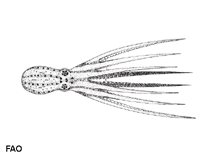Amphioctopus mototi (Norman, 1992)
Poison ocellate octopus| Native range | All suitable habitat | Point map | Year 2050 |

|
| This map was computer-generated and has not yet been reviewed. |
| Amphioctopus mototi AquaMaps Data sources: GBIF OBIS |
Classification / Names Κοινά ονόματα | Συνώνυμα | CoL | ITIS | WoRMS
Cephalopoda | Octopoda | Octopodidae | Octopodinae
Environment: milieu / climate zone / εύρος βάθους / distribution range Οικολογία
; εύρος βάθους 1 - 54 m (Αναφ. 96968). Tropical
Distribution Χώρες | Περιοχές FAO | Οικοσυστήματα | Παρουσίες | Εισαγωγές
Pacific Ocean.
Length at first maturity / Μέγεθος / Weight / Age
Γεννητική Ωρίμανση: Lm ? range ? - ? cm Max length : 32.0 cm TL αρσενικό/απροσδιόριστο; (Αναφ. 96968); μεγ. δημοσιευμένο βάρος: 300.00 g (Αναφ. 96968)
Its mantle length is 10 cm (Ref. 96968). Depths range from 1 to 54 m. Occurs on sandy substrates, often associated with coral heads or rubble. Deep lairs are excavated under coral heads or coral rubble on sand substrate. Appears to have crepuscular activity patterns. Lairs are surrounded by cast off gastropod shells which may have been collected for their secondary occupants, hermit crabs. Stomach contents have a high proportion of crustacean exoskeletal fragments. Eggs are laid in large numbers in festoons. The small egg size indicates hatchlings are planktonic. Possibly venomous based on the prominent warning coloration and being locally known as the "poison octopus". Live animals observed to bite objects willingly, uncommon amongst octopuses (Ref. 96968).
Life cycle and mating behavior Γεννητική Ωρίμανση | Αναπαραγωγή | Γεννοβολία | Eggs | Γονιμότητα | Larvae
Members of the class Cephalopoda are gonochoric. Male and female adults usually die shortly after spawning and brooding, respectively. Mating behavior: Males perform various displays to attract potential females for copulation. During copulation, male grasp the female and inserts the hectocotylus into the female's mantle cavity where fertilization usually occurs. Life cycle: Embryos hatch into planktonic stage and live for some time before they grow larger and take up a benthic existence as adults.
Main reference
Αναφορές | Συντονιστής | Συνεργάτες
Norman, M.D. and C.C. Lu. 2000. (Αναφ. 81752)
IUCN Red List Status
(Αναφ. 130435: Version 2024-2)
Least Concern (LC) ; Date assessed: 22 July 2014
CITES status (Αναφ. 108899)
Not Evaluated
CMS (Αναφ. 116361)
Not Evaluated
Threat to humans
Human uses
| FishSource |
Εργαλεία
Περισσότερες πληροφορίες
Τροφική Οικολογία
Οικολογία
Population dynamics
Αύξηση
Max. ages / sizes
Length-weight rel.
Length-length rel.
Length-frequencies
Mass conversion
Στρατολόγηση
Αφθονία
Max. ages / sizes
Length-weight rel.
Length-length rel.
Length-frequencies
Mass conversion
Στρατολόγηση
Αφθονία
Life cycle
Distribution
Human Related
Aquaculture profiles
Stamps, coins, misc.
Stamps, coins, misc.
Outreach
Taxonomy
Αναφορές
Διαδικτυακές πηγές
BHL | BOLD Systems | CISTI | DiscoverLife | FAO(Publication : search) | Fishipedia | GenBank (genome, nucleotide) | GloBI | Gomexsi | Google Books | Google Scholar | Google | PubMed | Δέντρο Ζωής | Wikipedia (Go, αναζήτηση) | Zoological Record
Estimates based on models
Preferred temperature
(Ref. 115969): 20.4 - 27, mean 25.2 (based on 136 cells).



